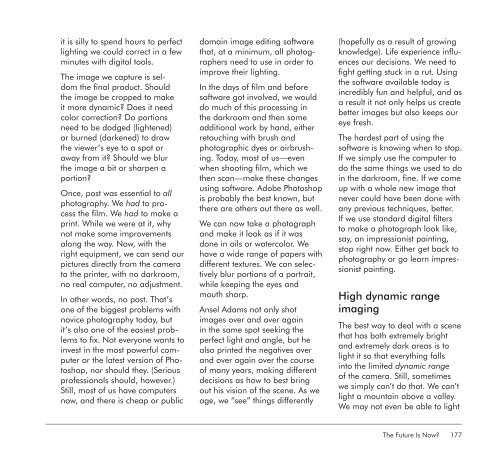Focus On Lighting Photos Focus on the Fundamentals.pdf
You also want an ePaper? Increase the reach of your titles
YUMPU automatically turns print PDFs into web optimized ePapers that Google loves.
it is silly to spend hours to perfect<br />
lighting we could correct in a few<br />
minutes with digital tools.<br />
The image we capture is seldom<br />
<strong>the</strong> final product. Should<br />
<strong>the</strong> image be cropped to make<br />
it more dynamic? Does it need<br />
color correcti<strong>on</strong>? Do porti<strong>on</strong>s<br />
need to be dodged (lightened)<br />
or burned (darkened) to draw<br />
<strong>the</strong> viewer’s eye to a spot or<br />
away from it? Should we blur<br />
<strong>the</strong> image a bit or sharpen a<br />
porti<strong>on</strong>?<br />
<str<strong>on</strong>g>On</str<strong>on</strong>g>ce, post was essential to all<br />
photography. We had to process<br />
<strong>the</strong> film. We had to make a<br />
print. While we were at it, why<br />
not make some improvements<br />
al<strong>on</strong>g <strong>the</strong> way. Now, with <strong>the</strong><br />
right equipment, we can send our<br />
pictures directly from <strong>the</strong> camera<br />
to <strong>the</strong> printer, with no darkroom,<br />
no real computer, no adjustment.<br />
In o<strong>the</strong>r words, no post. That’s<br />
<strong>on</strong>e of <strong>the</strong> biggest problems with<br />
novice photography today, but<br />
it’s also <strong>on</strong>e of <strong>the</strong> easiest problems<br />
to fix. Not every<strong>on</strong>e wants to<br />
invest in <strong>the</strong> most powerful computer<br />
or <strong>the</strong> latest versi<strong>on</strong> of <str<strong>on</strong>g>Photos</str<strong>on</strong>g>hop,<br />
nor should <strong>the</strong>y. (Serious<br />
professi<strong>on</strong>als should, however.)<br />
Still, most of us have computers<br />
now, and <strong>the</strong>re is cheap or public<br />
domain image editing software<br />
that, at a minimum, all photographers<br />
need to use in order to<br />
improve <strong>the</strong>ir lighting.<br />
In <strong>the</strong> days of film and before<br />
software got involved, we would<br />
do much of this processing in<br />
<strong>the</strong> darkroom and <strong>the</strong>n some<br />
additi<strong>on</strong>al work by hand, ei<strong>the</strong>r<br />
retouching with brush and<br />
photographic dyes or airbrushing.<br />
Today, most of us—even<br />
when shooting film, which we<br />
<strong>the</strong>n scan—make <strong>the</strong>se changes<br />
using software. Adobe <str<strong>on</strong>g>Photos</str<strong>on</strong>g>hop<br />
is probably <strong>the</strong> best known, but<br />
<strong>the</strong>re are o<strong>the</strong>rs out <strong>the</strong>re as well.<br />
We can now take a photograph<br />
and make it look as if it was<br />
d<strong>on</strong>e in oils or watercolor. We<br />
have a wide range of papers with<br />
different textures. We can selectively<br />
blur porti<strong>on</strong>s of a portrait,<br />
while keeping <strong>the</strong> eyes and<br />
mouth sharp.<br />
Ansel Adams not <strong>on</strong>ly shot<br />
images over and over again<br />
in <strong>the</strong> same spot seeking <strong>the</strong><br />
perfect light and angle, but he<br />
also printed <strong>the</strong> negatives over<br />
and over again over <strong>the</strong> course<br />
of many years, making different<br />
decisi<strong>on</strong>s as how to best bring<br />
out his visi<strong>on</strong> of <strong>the</strong> scene. As we<br />
age, we “see” things differently<br />
(hopefully as a result of growing<br />
knowledge). Life experience influences<br />
our decisi<strong>on</strong>s. We need to<br />
fight getting stuck in a rut. Using<br />
<strong>the</strong> software available today is<br />
incredibly fun and helpful, and as<br />
a result it not <strong>on</strong>ly helps us create<br />
better images but also keeps our<br />
eye fresh.<br />
The hardest part of using <strong>the</strong><br />
software is knowing when to stop.<br />
If we simply use <strong>the</strong> computer to<br />
do <strong>the</strong> same things we used to do<br />
in <strong>the</strong> darkroom, fine. If we come<br />
up with a whole new image that<br />
never could have been d<strong>on</strong>e with<br />
any previous techniques, better.<br />
If we use standard digital filters<br />
to make a photograph look like,<br />
say, an impressi<strong>on</strong>ist painting,<br />
stop right now. Ei<strong>the</strong>r get back to<br />
photography or go learn impressi<strong>on</strong>ist<br />
painting.<br />
High dynamic range<br />
imaging<br />
The best way to deal with a scene<br />
that has both extremely bright<br />
and extremely dark areas is to<br />
light it so that everything falls<br />
into <strong>the</strong> limited dynamic range<br />
of <strong>the</strong> camera. Still, sometimes<br />
we simply can’t do that. We can’t<br />
light a mountain above a valley.<br />
We may not even be able to light<br />
The Future Is Now? 177



